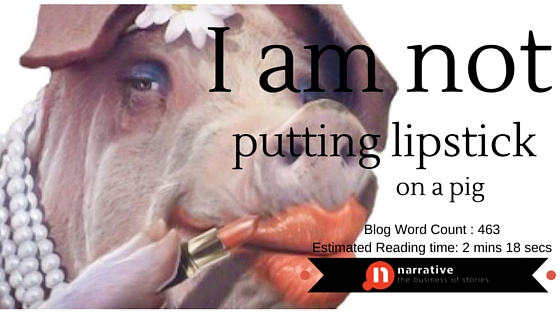Last year after I had finished presenting at an event, an audience member came up to me and said, ” So, storytelling is like putting lipstick on a pig”
I looked at him and calmly asked,” what do you mean?” He replied, ” No, I don’t mean it like its a futile attempt to disguise the true nature of something, but what I mean is that when people who struggle to become good presenters, after learning storytelling, become great presenters.”
I was shocked at how shallow his understanding of storytelling was. But I also understood where that comment came from. The majority of the online content on storytelling relates to presentations. Becoming a good presenter by storytelling is only one of the benefits of storytelling.
Storytelling can do a lot more
I am sure you are wondering, ” what more could stories do ?
To give you one example, lets look at how storytelling enabled British airways to develop and communicate business strategies.
*In 2001 British Airways faced a new set of problems. The world financial crisis, an ash cloud that stopped flights ,low cost competitors like Easy Jet and Ryanair and full-service ones like Virgin Atlantic. So, the company had to address long-term issues and formulate solutions for future.
The chief economist of BA selected eight experts from BA’s employees across the whole company to form a ‘Halo Group’.
The group decided on 3 key areas they would come up with strategies for. One of which was: Uncertainties and how to prepare for them.
Halo Group worked on a new story method called Group Storytelling for predicting events and outcomes to form strategies.
This method requires an individual to tell a story and other members of the group to participate in the activity and add their own stories. Everyone contributes to create a story. The knowledge created at the end of this process was a combination of the knowledge from each participant.
For example: Technical staff would predict an event in the future
“(…)the handling pilot got into a mindset that take off clearance had been given. It was noticed too late by ground authorities , and the aircraft had crossed the holding point.
Then a group of people would share their individual anticipated experiences in simple stories. The analysis of these stories was then published for the pilots to make them future ready. Sharing their individual experience in simple stories makes it easier for pilots to manage complicated situations in future.
This is just one of the example of how storytelling enabled British airways develop and communicate business strategies to make the company future ready in an uncertain environment. And this certainly was not an example where we used Storytelling to become a great presenter or in the words of the audience member I met at the event – Put lipstick on a pig.
*Source: KNOWLEDGE MANAGEMENT IN AIRLINE INDUSTRY: CASE STUDY FROM THE BRITISH AIRWAYS
"I attended your story telling course some time back. And I've enjoyed keeping up my knowledge with your blog. You may not have realised however, that the Whole of Government is implementing Internet Seperation. Hence I'm not able to access the links to read your articles. Could I suggest including a QR code in your emails so that I can use my mobile to scan it and gain immediate access to the article? It would be most helpful"










